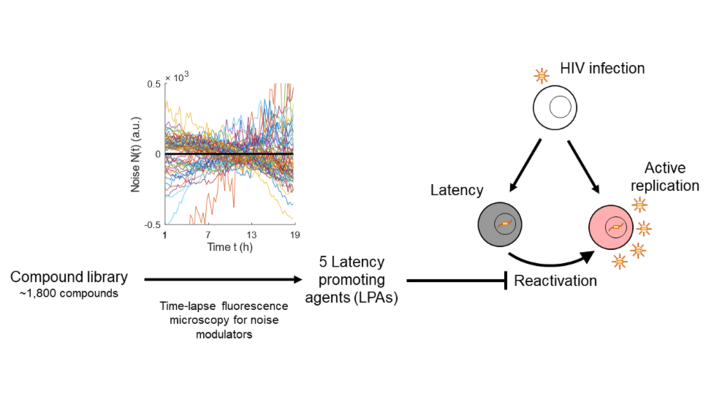Illinois scientists screening for gene expression fluctuations reveal latency-promoting agents of HIV
The human immunodeficiency virus (HIV) attacks cells that help the body fight infection, thus making the human body more vulnerable to other infections and diseases. Until this day, HIV remains a global pandemic of large proportions. Upon infection, inactive or latently infected cells capable of reactivating following treatment removal remain the major barrier to curing HIV.
Drug treatments currently available to remove the latent reservoir are ineffective, and there are a limited number of compounds capable of suppressing reactivation of latent HIV.
Reactivation from latency is known to be stochastic, and previous research utilized gene expression fluctuations, or “noise”, to identify chemical compounds that control the latency-active replication decision of HIV. These research studies resulted in discovering only a limited number of latency promoting agents (LPAs) and screening resulted primarily in compounds that synergize reactivation from latency.
This led to initiation of the research study “Screening for gene expression fluctuations reveals latency-promoting agents of HIV,” by Center for Biophysics and Quantitative Biology Affiliate Professor and Department of Bioengineering Professor Roy Dar. The research team included graduate student Yiyang Lu, undergraduate students Jennifer M. Moy and Harpal Singh, and postdoctoral research associate Kathrin Bohn-Wippert in the Department of Bioengineering at UIUC, and Patrick J. Pazerunas in the Department of Chemical Engineering at UIUC.
The research team implemented a high-throughput single-cell time-lapse fluorescence microscopy drug screen on a minimal HIV gene circuit for ~1800 drug perturbations over 48h. The targeted gene circuit consisted of the key master-regulator of HIV called tat which is known to bias viral decision-making.

“This long-duration fluorescence correlation spectroscopy approach, or time-series drug screen, enabled the quantification of shifts in both noise magnitude and noise frequency by the drug perturbations,” says Professor Dar.
“Measurements narrowed down the library of drugs from ~1800 to 115 noise modulators for further testing on a full-length latent HIV system. Of the 115 noise modulators, three compounds were found to be LPAs, and further investigations into functional analogues yielded two additional LPAs for a total of five reported in the project’s final paper.” says lead author Yiyang Lu.
The time-series drug screen is considered a novel experimental approach used to detect gene expression noise modulators of viral gene circuits and may be extended to bias decisions in other noise-driven systems or diseases. Professor Dar believes that the newly discovered five LPAs will expand the palette of currently existing LPAs available to the HIV cure research community and potentially lead to novel mechanisms for “blocking and locking” latency. “One of the five LPAs discovered is FDA approved and holds promise in its safety and availability,” Dar adds.
The complete findings of this research study are published in the Proceedings of the National Academy of Sciences and can be found here.
Published June 02, 2021 15:02